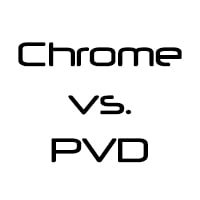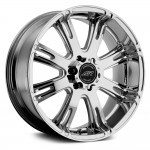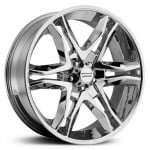
Most people that aren’t in the wheel business or don’t research wheels very often have probably never heard of PVD. What does PVD stand for? PVD means Physical Vapor Deposition. It’s a powder coat that looks very similar to chrome that gives that shame shiny appearance. More and more wheel and rim manufacturers are going into the PVD finish. It gives a chrome look without the downfalls of chrome. In this article we will go into detail about why we think PVD is a better choice vs. going with a chrome wheel.
Breaking down PVD vs. Chrome

PVD wheels are actually lighter than chrome wheels. They can be two to three pounds lighter. The material used for powder coating PVD wheels weighs less than the chrome material which in turn helps your vehicle out by reducing the rotating mass. This will give you an opportunity to get off the line just a little bit quicker when every pound counts.
One of the major concerns for everyone when picking wheels is: “How do they hold up in winter weather conditions?” PVD is made to accept even the harshest of winter conditions. They require just the basic cleaning with soap and water when you do your routinely scheduled car wash. If you live up in the northern regions where there is a lot of snow and ice all winter, the road crews put down salt and Magnesium Chloride to help fight slippery driving conditions. Those two components and chrome do not get along and they actually eat away at chrome over time. It is also known to make the chrome crack, peel or pit. This is why you see a lot of people taking off their chrome wheels during the winter time. With PVD wheels, you won’t have to do that anymore.
Why choose PVD over Chrome?

One of the big benefits from PVD wheels is if by chance you do damage your PVD wheel, (let’s be real, accidents do happen) it is easy and inexpensive to get them re-coated. Chrome wheels, however, are difficult and expensive to re-coat. You will notice a lot of warranty coverages only last one to two years with chrome wheels. With PVD, most of the time are guaranteed well over three years.
One of the components used to make up chrome is hexavalent chromium with is a very toxic material which is bad for the environment. PVD wheels are manufactured with environmentally friendly products. This paragraph alone should be enough to decide to use a “green” product that won’t hurt the sensitive environment we live in.
To sum up this article, PVD has all the benefits of powder-coating with the same look as chrome. They are environmentally friendly, will hold up in extreme winter weather with the salt and Magnesium Chloride, lasts longer, easier to repair if an accident does happen and has a longer manufacturer warranty.

Thanks for the breakdown guys. This is exactly what I was wondering. I kept seeing PVD wheels and didn’t know what the differences were between PVD and chrome. Very informative!
Great stuff. Now I know the difference. I think I’m going to go for some PVD wheels now with you guys after reading this. Thanks!
Glad you enjoyed our article and we will be here for your questions. 800-232-0734
One other question. Does the pvd finish require polishing to keep them shinning like new? I know you guys said just soap and water for cleaning.
Soap and water will do it!
Thanks!
I keep reading that PVD wheels are easy and cheap to repair… However, I have called every wheel repair shop within 150 miles and no one actually repairs them… The best option I have found is a little over $250 per wheel to swap mine for ones that have already been striped and recoated… If you are thinking about PVD wheels, take some time and see if you can find anyone who will actually repair them, because I cannot!
On the PVD wheels Ford uses on it’s new vehicles, is the rims that are being coated made out of steel or aluminum or some other material.
I’m going to say the wheels are aluminum because Steel wheels run at a premium cost due to the fact that it’s harder to work with but a quick google search or call to ford will clear up this confusion.
Will PVD peel
According to sources I’ve seen, it is much more durable than Chrome but can also pit or peel over the years. For a comparison, chrome tends to peel or pit within 12 – 24 months whereas PVD will last years beyond that. If you were to mess them up on the curb, they could be repaired easier than with chrome.
There’s pros and cons to each one really.